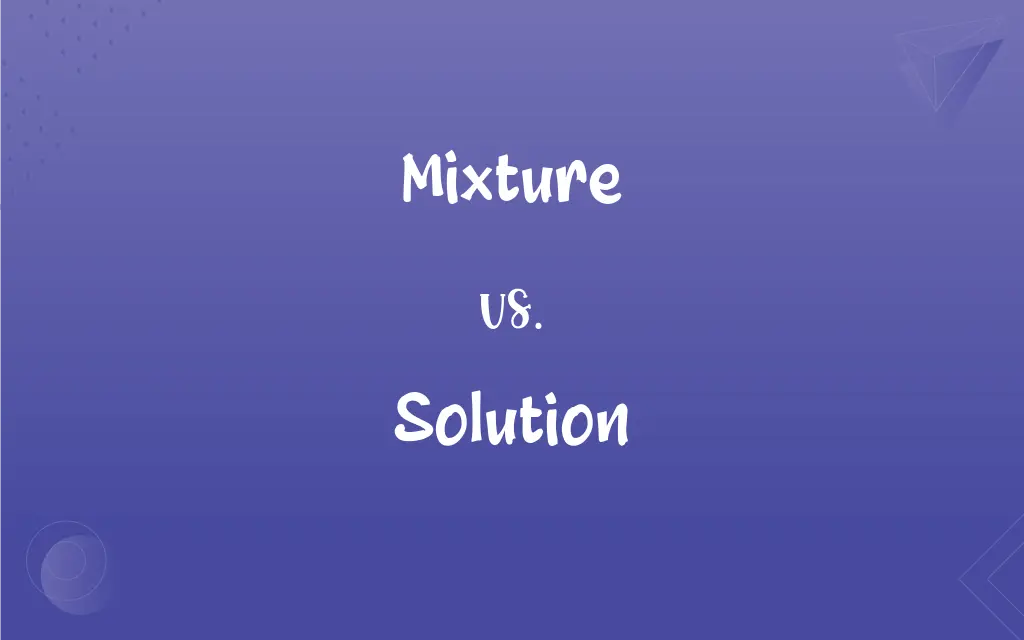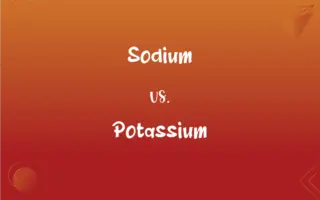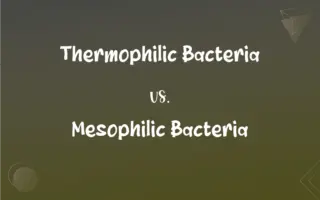Mixture vs. Solution: What's the Difference?
Edited by Janet White || By Harlon Moss || Updated on October 21, 2023
A mixture combines two or more substances without chemical bonding, while a solution has one substance dissolved in another.

Key Differences
A mixture is a physical combination of two or more substances where each retains its own properties. On the other hand, a solution is formed when one substance dissolves into another, resulting in a uniform composition.
In a mixture, components can usually be separated by mechanical means, like filtering or handpicking. For a solution, separating components often requires processes like evaporation or distillation.
Mixtures can be either homogeneous (uniform in composition) or heterogeneous (non-uniform), whereas solutions are always homogeneous due to the complete dissolution of one substance into another.
The components of a mixture can be present in any proportion, without fixed ratios. In a solution, there's a solute (the dissolved substance) and a solvent (the substance in which the solute is dissolved), often with defined concentrations.
While mixtures might show variations in composition and properties across samples, solutions ensure consistent characteristics throughout the entire volume, guaranteeing uniformity.
ADVERTISEMENT
Comparison Chart
Composition
Variable; no fixed ratio
Solute in solvent; often defined concentration
Homogeneity
Can be homogeneous or heterogeneous
Always homogeneous
Separation
Mechanical means possible
Requires processes like evaporation
Chemical Bonding
No chemical bonds between components
Solute dissolved in solvent
Examples
Sand and salt, oil and water
Salt in water, sugar in tea
ADVERTISEMENT
Mixture and Solution Definitions
Mixture
A combination of two or more substances, each retaining its own properties.
The bowl contained a mixture of nuts and dried fruits.
Solution
A liquid system with a consistent concentration throughout.
The scientist tested the pH of the solution.
Mixture
An amalgamation without chemical bonding.
His trail mix is a tasty mixture of various ingredients.
Solution
An outcome where substances merge to form a uniform phase.
He mixed the chemicals to achieve the desired solution.
Mixture
A physical blend where substances can be separated.
She sieved the mixture to remove the larger particles.
Solution
A homogeneous blend of a solute dissolved in a solvent.
She prepared a solution of sugar in warm water.
Mixture
An assembly that can be either uniform or varied in composition.
The jar was filled with a mixture of beads of different sizes.
Solution
A stable dispersion without visible particles.
The drink was a clear solution without any sediment.
Mixture
A compound with variable composition.
The artist created a unique mixture of colors on his palette.
Solution
A compound where one component's molecules disperse among another's.
In the lab, she made a solution by adding salt to distilled water.
Mixture
The act or process of mixing
An alloy made from the mixture of two metals.
Solution
A method or process of dealing with a problem
Sought a solution to falling enrollments.
Mixture
The condition of being mixed
The inevitable mixture of different cultures in big cities.
Solution
The answer to a problem or the explanation for something
The solution to the mystery.
FAQs
How is a solution different from a mixture?
A solution has one substance dissolved in another, leading to a uniform composition.
What makes a mixture heterogeneous?
A heterogeneous mixture has visibly different substances or phases.
How is a solution's concentration determined?
Concentration refers to the amount of solute in a given quantity of solvent.
How can I concentrate a solution?
By reducing the solvent or adding more solute.
Why can't I see solute particles in a solution?
They're uniformly dispersed at the molecular or ionic level.
Are alloys mixtures or solutions?
Alloys are solid solutions of metals.
Is tea a solution?
Tea is largely a solution, but if it has undissolved particles, it's also a mixture.
Can I have a mixture of two solutions?
Yes, when two solutions are combined, they form a mixture.
What is a mixture?
A mixture is a combination of two or more substances without chemical bonding.
Can I separate the components of a mixture?
Yes, mixtures can usually be separated by mechanical means.
Are solutions always liquid?
No, solutions can be solid, liquid, or gas, but the liquid form is most common.
Can solutions be separated?
Yes, through processes like distillation or evaporation.
Why are some mixtures cloudy?
The particles in some mixtures scatter light, making them appear cloudy.
What happens to the properties of substances in a mixture?
In mixtures, each substance retains its individual properties.
Can mixtures be homogeneous?
Yes, when the composition is uniform throughout, it's a homogeneous mixture.
What's the solute in a sugar-water solution?
The solute is sugar, as it's the component that gets dissolved.
Are all mixtures soluble?
No, not all components in mixtures dissolve in each other.
Can the components of a solution react with each other?
In a stable solution, the components don't react but are merely dissolved.
Can air be considered a mixture?
Yes, air is a mixture of various gases like nitrogen, oxygen, and carbon dioxide.
Is saltwater a mixture or solution?
Saltwater is a solution because the salt is dissolved in the water.
About Author
Written by
Harlon MossHarlon is a seasoned quality moderator and accomplished content writer for Difference Wiki. An alumnus of the prestigious University of California, he earned his degree in Computer Science. Leveraging his academic background, Harlon brings a meticulous and informed perspective to his work, ensuring content accuracy and excellence.
Edited by
Janet WhiteJanet White has been an esteemed writer and blogger for Difference Wiki. Holding a Master's degree in Science and Medical Journalism from the prestigious Boston University, she has consistently demonstrated her expertise and passion for her field. When she's not immersed in her work, Janet relishes her time exercising, delving into a good book, and cherishing moments with friends and family.
































































